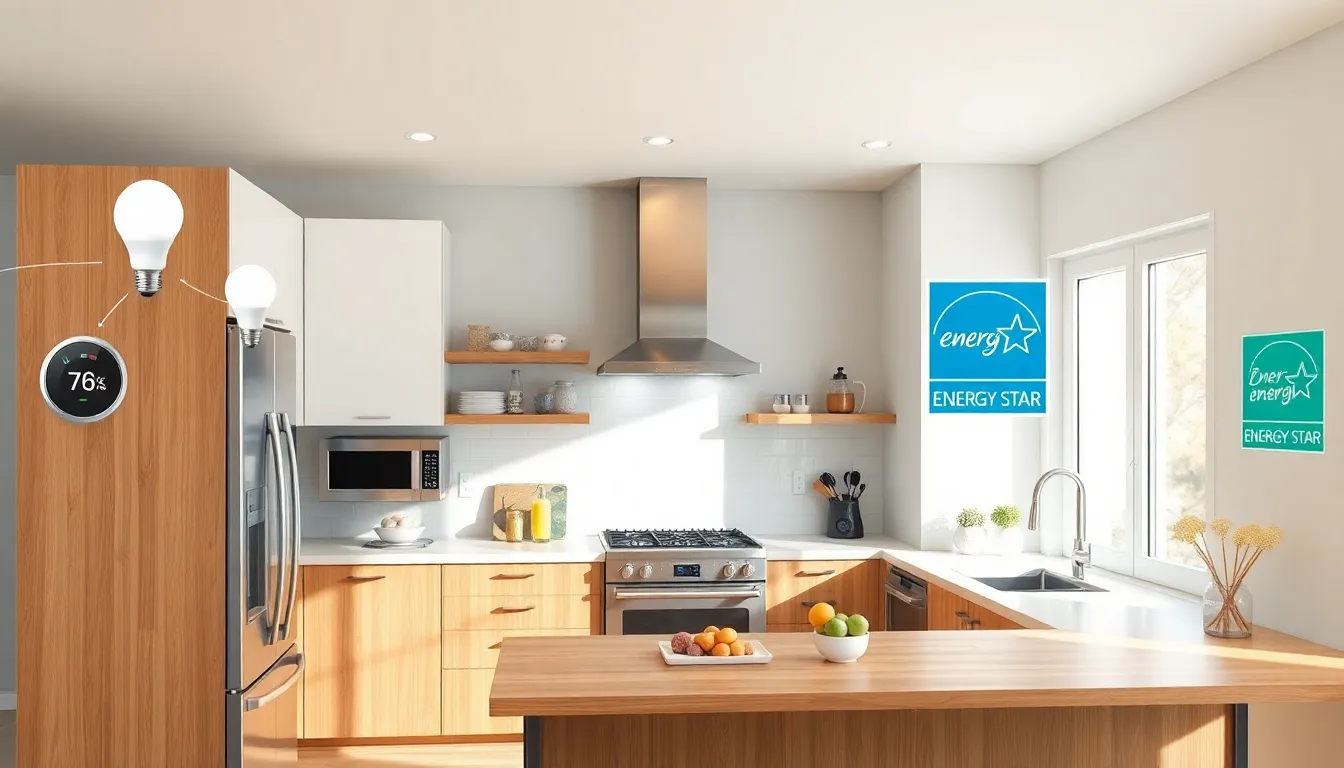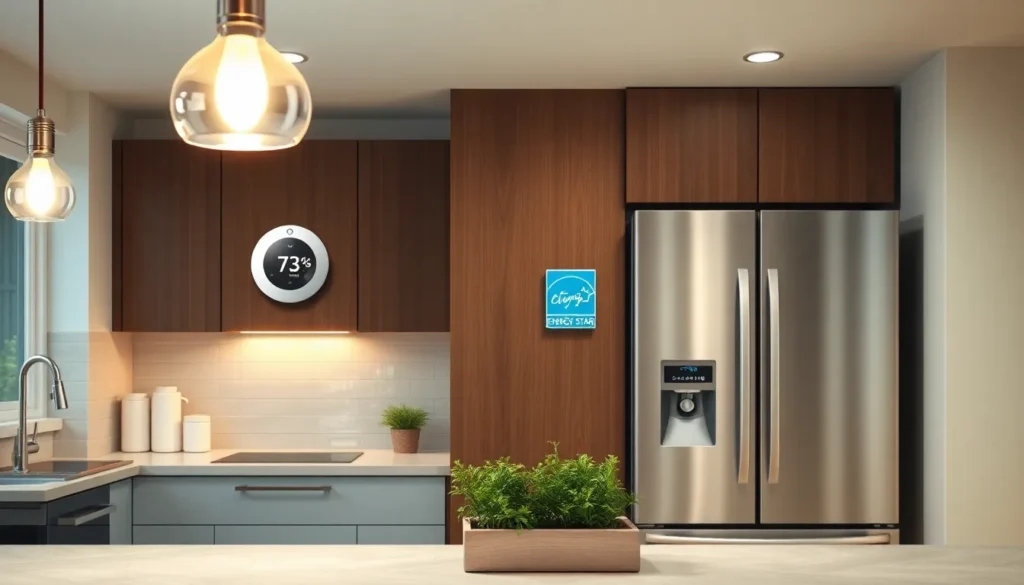In a world where energy bills can skyrocket faster than a caffeinated squirrel, energy-efficient gadgets are the superheroes we never knew we needed. These nifty devices not only save the planet but also keep wallets from crying at the end of the month. Who knew saving the Earth could be so easy—and so stylish?
Table of Contents
ToggleWhat Are Energy-Efficient Gadgets?
Energy-efficient gadgets refer to devices designed to use less energy while still delivering optimal functionality. These products often incorporate advanced technologies to minimize power consumption without sacrificing performance. Examples include LED light bulbs, smart thermostats, and Energy Star rated appliances.
LED light bulbs consume up to 75% less energy compared to traditional incandescent bulbs. Smart thermostats adjust heating and cooling based on user behavior, leading to energy savings of up to 15%. Energy Star certified appliances meet strict efficiency guidelines set by the U.S. Environmental Protection Agency, making them a preferred choice for consumers.
Smart power strips prevent energy wastage by cutting off power to devices in standby mode. Energy-efficient gadgets not only reduce energy bills but also lower carbon footprints significantly. Many of these devices are also designed with modern aesthetics, appealing to consumers’ desire for stylish and eco-friendly options.
Consumers benefit from government incentives and rebates when investing in energy-efficient models. This financial support encourages wider adoption and helps offset initial costs. Retailers often highlight energy-efficient product features clearly on packaging, making it easier for shoppers to identify them.
Overall, energy-efficient gadgets play a crucial role in promoting sustainable living while meeting consumers’ needs for performance and style. The transition to these devices represents a collective effort toward environmental responsibility and energy conservation.
Benefits of Using Energy-Efficient Gadgets

Energy-efficient gadgets provide significant advantages in both cost and environmental sustainability. Understanding these benefits highlights their essential role in modern living.
Cost Savings
Cost savings emerge as one of the primary benefits of energy-efficient gadgets. Consumers can expect reductions in energy bills by using devices designed to consume less power. For example, switching to LED light bulbs can cut electricity costs by up to 75% compared to traditional bulbs. Smart thermostats offer savings up to 15% by automatically adjusting temperatures based on occupancy. Energy Star rated appliances frequently provide further savings through optimized energy use. Tax incentives and rebates often accompany these purchases, enhancing financial benefits. Investing in energy-efficient models leads to long-term savings not just in monthly expenses but also in replacement and maintenance costs.
Environmental Impact
Environmental impact plays a crucial role in the appeal of energy-efficient gadgets. Devices designed to minimize power consumption contribute to lower greenhouse gas emissions. Energy-efficient products help reduce the overall demand for energy, easing the strain on power plants. For instance, using a smart power strip can prevent wasted energy from devices left in standby mode. Each efficient choice has a cumulative effect, helping to foster a cleaner atmosphere. Furthermore, adopting energy-efficient solutions promotes responsible consumption habits. Collectively, these actions encourage a shift toward sustainability, creating a healthier environment for future generations.
Popular Energy-Efficient Gadgets on the Market
Energy-efficient gadgets are increasingly in demand. They help consumers save money while supporting eco-friendly initiatives.
Smart Thermostats
Smart thermostats automatically adjust heating and cooling based on occupancy, enhancing energy savings. Some models can lead to savings of up to 15% on annual energy costs. Users can control these devices remotely through smartphone apps, providing convenience and efficiency. Advanced features enable learning algorithms that adapt to a household’s routines, ensuring optimal temperature settings. Additionally, many utility companies offer rebates for the purchase of smart thermostats, increasing the financial benefits.
LED Lighting
LED lighting offers a significant advantage over traditional bulbs, consuming up to 75% less energy. These lights have longer lifespans, often lasting over 25,000 hours compared to just 1,000 hours for incandescent bulbs. Various styles and colors are available, making LED options versatile for any home decor. The reduced energy consumption not only lowers electricity bills but also decreases greenhouse gas emissions. Many consumers appreciate the instant brightness and durability of LED lights, making them a popular choice for both indoor and outdoor settings.
Energy Star Appliances
Energy Star appliances meet strict efficiency guidelines, significantly lowering energy consumption. These devices use about 10-50% less energy than standard models, ideal for environmentally conscious consumers. From refrigerators to washing machines, options abound that enhance performance while minimizing resource usage. Recognizable labels typically help shoppers identify products with the highest efficiency ratings. Many manufacturers also provide rebates or tax credits to those who invest in Energy Star appliances, making them financially attractive.
How to Choose the Right Energy-Efficient Gadgets
Choosing energy-efficient gadgets requires careful consideration of various factors. Prioritizing specific energy needs helps consumers make informed decisions.
Assessing Your Energy Needs
Identifying energy requirements is the first step. Understanding current energy usage promotes effective gadget choice. Evaluate daily habits and assess which appliances consume the most energy. For instance, HVAC systems often account for a significant percentage of energy bills. Focus on upgrading devices that offer substantial savings while enhancing comfort. Smart thermostats, designed for precise temperature control, provide flexibility in managing energy consumption. Consumers should consider the size of their home to select devices suited for efficient performance.
Reading Energy Labels
Energy labels provide crucial information for comparing gadgets. For example, ENERGY STAR certification indicates products meet strict efficiency standards. Consumers should look for appliances with lower kilowatt-hour ratings for indication of energy use. Regularly reviewing these labels helps in identifying potential cost savings. Familiarizing oneself with terms such as “Annual Energy Cost” simplifies the assessment process. Knowing the distinctions between grades can guide consumers toward superior options. Reading reviews and ratings from trusted sources can enhance confidence in purchasing decisions.
Embracing energy-efficient gadgets is a smart choice for anyone looking to save money and reduce their environmental footprint. By investing in these innovative devices, consumers can enjoy significant savings on energy bills while contributing to a more sustainable future.
With options like LED bulbs and smart thermostats, it’s easier than ever to make eco-friendly choices that don’t compromise on performance or style. As technology continues to evolve, the market for energy-efficient gadgets will only expand, offering even more opportunities for individuals to make a positive impact.
Ultimately, adopting these gadgets is not just about cutting costs; it’s about fostering a culture of sustainability that benefits everyone.





